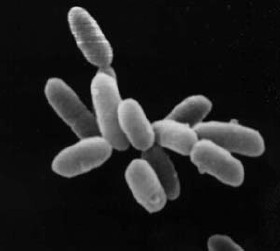Related Research Articles

The Firmicutes are a phylum of bacteria, most of which have gram-positive cell wall structure. A few, however, such as Megasphaera, Pectinatus, Selenomonas and Zymophilus, have a porous pseudo-outer membrane that causes them to stain gram-negative. Scientists once classified the Firmicutes to include all gram-positive bacteria, but have recently defined them to be of a core group of related forms called the low-G+C group, in contrast to the Actinobacteria. They have round cells, called cocci, or rod-like forms (bacillus).

Euryarchaeota is a phylum of archaea. It is one of two phyla of archaea, the other being crenarchaeota. Euryarchaeota are highly diverse and include methanogens, which produce methane and are often found in intestines, halobacteria, which survive extreme concentrations of salt, and some extremely thermophilic aerobes and anaerobes, which generally live at temperatures between 41 and 122 °C. They are separated from the other archaeans based mainly on rRNA sequences and their unique DNA polymerase.
The Thermoprotei is a class of the Crenarchaeota.
The Thermodesulfobacteria are a phylum of thermophilic sulfate-reducing bacteria.
The Aquificaceae family are bacteria that live in harsh environmental settings such as hot springs, sulfur pools, and hydrothermal vents. Although they are true bacteria as opposed to the other inhabitants of extreme environments, the Archaea, Aquificaceae genera are an early phylogenetic branch.
Fibrobacteres is a small bacterial phylum which includes many of the major rumen bacteria, allowing for the degradation of plant-based cellulose in ruminant animals. Members of this phylum were categorized in other phyla. The genus Fibrobacter was removed from the genus Bacteroides in 1988.
The Gemmatimonadetes are a phylum of bacteria established in 2003. The phylum contains two classes Gemmatimonadetes and Longimicrobia.
In taxonomy, the Acidilobales are an order of the Thermoprotei.

Sulfolobaceae are a family of the Sulfolobales belonging to the domain Archaea. The family consists of several genera adapted to survive environmental niches with extreme temperature and low pH conditions.
In taxonomy, the Thermoproteaceae are a family of the Thermoproteales.
Nitrospirae is a phylum of bacteria. It contains only one class, Nitrospira, which itself contains one order (Nitrospirales) and one family (Nitrospiraceae). It includes multiple genera, such as Nitrospira, the largest. The first member of this phylum, Nitrospira marina, was discovered in 1985. The second member, Nitrospira moscoviensis, was discovered in 1995.

Bacterial phyla constitute the major lineages of the domain Bacteria. While the exact definition of a bacterial phylum is debated, a popular definition is that a bacterial phylum is a monophyletic lineage of bacteria whose 16S rRNA genes share a pairwise sequence identity of ~75% or less with those of the members of other bacterial phyla.
Armatimonadetes is a phylum of gram-negative bacteria.
Nanohaloarchaea is a clade of diminutive archaea with small genomes and limited metabolic capabilities, belonging to the DPANN archaea. They are ubiquitous in hypersaline habitats, which they share with the extremely halophilic haloarchaea.
The Desulfurobacteriaceae family are bacteria belonging to the Aquificae phylum.

DPANN is a superphylum of Archaea first proposed in 2013. Many members show novel signs of horizontal gene transfer from other domains of life. They are known as nanoarchaea or ultra-small archaea due to their smaller size (nanometric) compared to other archaea.

Candidate phyla radiation is a large evolutionary radiation of bacterial lineages whose members are mostly uncultivated and only known from metagenomics and single cell sequencing. They have been described as nanobacteria or ultra-small bacteria due to their reduced size (nanometric) compared to other bacteria. Originally, it has been suggested that CPR represents over 15% of all bacterial diversity and may consist of more than 70 different phyla. However, a recently proposed standardized bacterial taxonomy based on relative evolutionary divergence found that CPR represents a single phylum. CPR lineages are generally characterized as having small genomes and lacking several biosynthetic pathways and ribosomal proteins. This has led to the speculation that they are likely obligate symbionts.
Modulibacteria is a bacterial phylum formerly known as KS3B3 or GN06. It is a candidate phylum, meaning there are no cultured representatives of this group. Members of the Modulibacteria phylum are known to cause fatal filament overgrowth (bulking) in high-rate industrial anaerobic wastewater treatment bioreactors.
There are several models of the branching order of bacterial phyla, one of these is the Genome Taxonomy Database (GTDB).
References
- ↑ Nobu, M. K., Dodsworth, J. A., Murugapiran, S. K., Rinke, C., Gies, E. A., Webster, G., ... & Jørgensen, B. B. (2016) Phylogeny and physiology of candidate phylum 'Atribacteria' (OP9/JS1) inferred from cultivation-independent genomics. The ISME journal, 10(2), 273-286.
- ↑ Carr, S. A., Orcutt, B. N., Mandernack, K. W., & Spear, J. R. (2015). Abundant Atribacteria in deep marine sediment from the Adélie Basin, Antarctica. Frontiers in microbiology, 6.
- ↑ Christian Rinke et al 2013. Insights into the phylogeny and coding potential of microbial dark matter. Nature Volume: 499, Pages: 431–437 doi:10.1038/nature12352
- ↑ Hug, L. A. et al. 2016, A new view of the tree of life. Nature Microbiology, 1, 16048.
- ↑ Vuillemin, Aurèle; Vargas, Sergio; Coskun, Ömer K.; Pockalny, Robert; Murray, Richard W.; Smith, David C.; D’Hondt, Steven; Orsi, William D. (2020-07-11). "Atribacteria reproducing over millions of years in the Atlantic abyssal subseafloor". dx.doi.org. Retrieved 2021-03-26.
- ↑ Sayers; et al. "Atribacterota". National Center for Biotechnology Information (NCBI) taxonomy database. Retrieved 2021-03-20.
- ↑ J.P. Euzéby. "Atribacterota". List of Prokaryotic names with Standing in Nomenclature (LPSN). Retrieved 2021-06-27.
- ↑ Mendler, K; Chen, H; Parks, DH; Hug, LA; Doxey, AC (2019). "AnnoTree: visualization and exploration of a functionally annotated microbial tree of life". Nucleic Acids Research. 47: 4442–4448. doi: 10.1093/nar/gkz246 .
- ↑ "GTDB release 06-RS202". Genome Taxonomy Database .